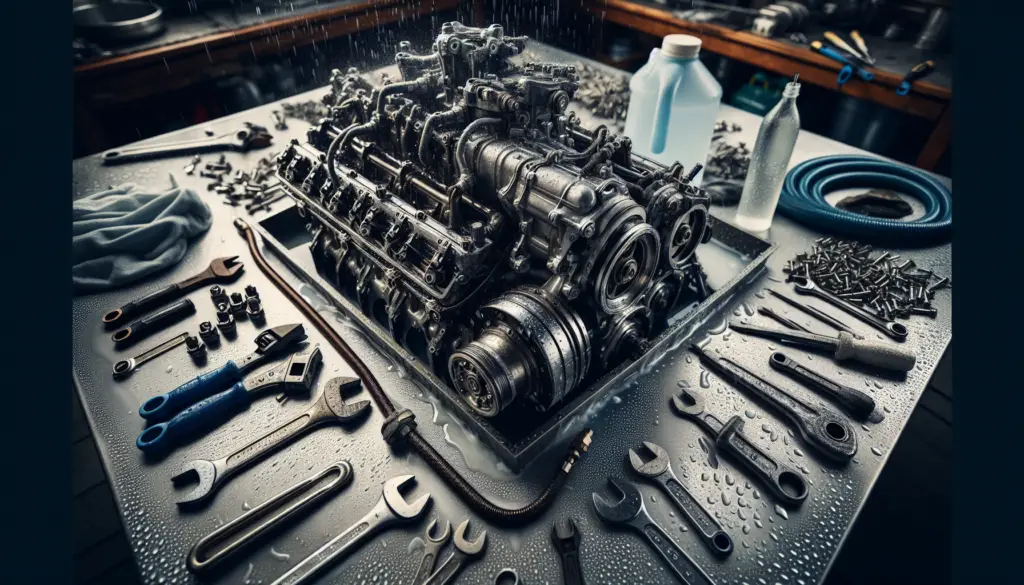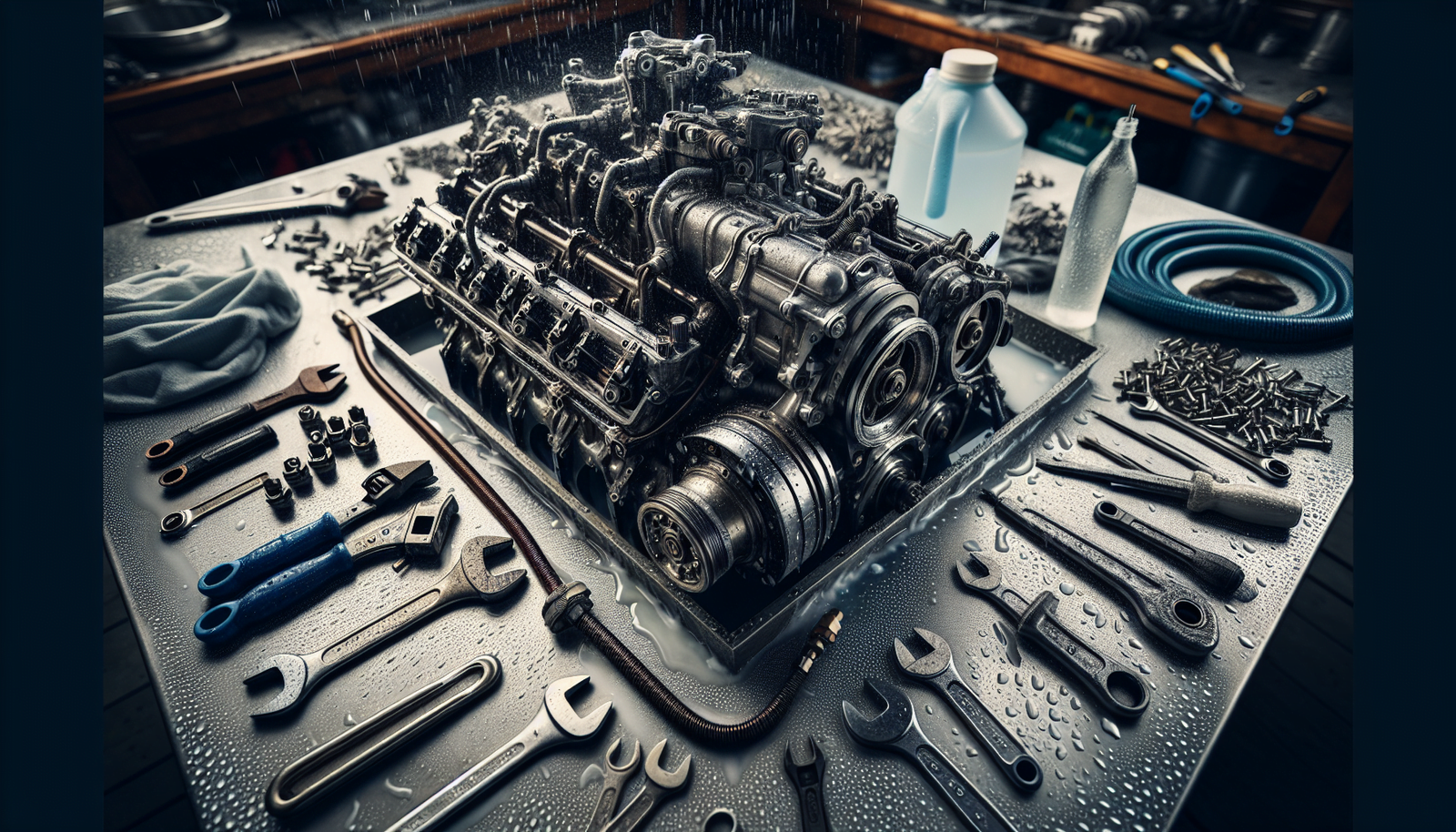Sailing the seas in your trusty boat can be a thrilling adventure, but maintaining your boat’s engine is a crucial aspect of this journey that cannot be understated. This article – “How To Properly Flush Your Boat Engine After Use” – offers comprehensive guidance on carrying out this vital task. Packed with expert advice and useful tips, it makes it easy for you to extend the lifespan of your engine. From the required supplies to step-by-step instructions, This article has everything you need to get your boat engine clean and ready for your next maritime adventure. Maintenance doesn’t have to be a nightmare, and ensuring your boat engine is thoroughly flushed after use can be your secret to seamless voyages.

Understanding Why Flushing is Necessary
Just as one wouldn’t venture into the saline sea without taking protective measures for their skin, your boat engine also needs care and maintenance after exposure to saltwater. Flushing your boat engine is an effective way to keep your boat in good working condition and ensure you avoid unnecessary service or replacement costs. Let’s delve into why flushing your boat engine is so necessary.
The Risks of Saltwater Exposure
When you take your boat out to sea, the engine is constantly exposed to saltwater. This can lead to a number of issues. Saltwater is incredibly corrosive and can quickly cause damage to several engine parts. In addition, salt can accumulate and solidify, leading to blockages that may hamper the engine’s performance.
Preventing Corrosion and Blockages
Regularly flushing your boat’s engine with freshwater after every voyage helps rid the engine of salt and any other debris it may have picked up along the way. This flushing process dilutes and removes the salt, preventing the chance of corrosion and blockages and prolonging the life of your engine.
Extending Your Engine’s Lifespan
Just like any mechanical equipment, your boat’s engine has a lifespan. Periodic flushing won’t only keep your engine running smoothly, but also extend its lifespan considerably. This practice can save you substantial costs in the long run, as it can prevent the need for frequent repairs or ultimately replacing the engine due to severe damage.
Knowing When To Flush The Engine
While it is good to regularly maintain and take care of your boat engine, knowing when exactly to flush it can make a huge difference to its performance and longevity. The timing can vary based on usage and exposure to saltwater.
Frequency based on Usage
If you often take your boat out, it’s advisable to flush the engine after every trip. This will ensure that no salt or grime sits in the engine for an extended period causing damage.
Frequency based on Exposure to Saltwater
If the engine has been exposed to saltwater, regardless of the duration, flushing after every journey is vital. However, if you are using your boat in freshwater, you can reduce the flushing frequency to once every few trips.
Importance of Regular Maintenance
While flushing is an important aspect of boat maintenance, it is not the only one. Regularly checking your engine for any signs of wear and tear, changing the oil, and getting it serviced at regular intervals can significantly enhance your engine’s performance and longevity.
Preparing for The Flushing Process
Before plunging into the flushing process head-on, certain preparatory steps are important to ensure the safety and efficiency of the procedure.
Safety Measures to Follow
First and foremost, make sure to wear protective clothing, eye gear, and gloves. Even though you’re dealing with freshwater, splashes and spills can still happen. Moreover, make sure the engine is switched off before starting the flushing process.
Gathering Necessary Tools and Equipment
To flush your boat engine, you’ll need a garden hose with good water pressure, a pair of flush muffs or a built-in flushing system depending on your boat’s model, and necessary connectors. It’s good practice to always have these tools in hand to avoid any last-minute rushes.
Securing Your Boat for the Process
Before starting the process, secure your boat properly. If it’s on a trailer, make sure the trailer is steady. If your boat is docked, tie it securely to avoid any movement during the process.
Choosing The Right Flushing Method
Different boat engines need different flushing methods. Picking the right one is essential to ensure effective cleaning and avoid any potential damage to your engine.
Deciding Between On-Water Flush and Off-Water Flush
If your engine has a built-in flush point, you can utilize the on-water flush method. This allows you to flush the engine while it’s still mounted on the dock. However, if your engine doesn’t have this feature, performing an off-water flush using flush muffs is the next best option.
Pros and Cons of Using Flush Muffs
While they can be a bit tricky to handle, flush muffs are a popular choice among boaters who don’t have a built-in flush point. They need to be fitted correctly around the water intake and require manual adjustments to avoid falling off.
Advantages of Having A Built-in Flushing System
Having a built-in system simplifies the process as it does not require submersion or hull identification. Plus, it minimizes the risk of improper fitting which is common with flush muffs, thus maximizing the efficiency of the process.
Step-By-Step Guide to Flushing Your Boat Engine
Flushing your boat engine might seem like a difficult task, but with correct steps and a little practice, anyone can learn to do it.
Turning On The Water Supply
After setting up the flushing system, turn on the water supply. However, make sure the engine isn’t running at this point to avoid dry-running and probable engine damage.
Connecting the Hose to the Flushing Port
Next, connect the garden hose to the flushing port. Make sure it’s securely connected to prevent any leakage or accidents.
Running the Engine During Flushing
After ensuring the water supply is working well, start the engine and let it run at idle speed. This helps the fresh water circulate throughout the engine, pushing out the salt and grime.
Keeping Track of Flushing Time
Ideally, flushing should last for about 5 to 10 minutes. However, it can vary depending on the engine type, its size, and the level of saltwater exposure. It’s a good idea to refer to your engine’s manual for specific guidelines.
Avoiding Common Mistakes During Flushing
While flushing your boat engine isn’t a particularly challenging task, there are certain common mistakes you should avoid ensuring the process is effective and safe.
Running the Engine Without Water Supply
Nothing can cause more harm to your boat engine than running it without water while flushing. Always ensure water is running before and throughout the time the engine is operational.
Using High-Pressure Water
While it might seem like high-pressure water will do a better job at flushing out the salt, it can actually lead to water entering areas it shouldn’t. Using normal pressure water is usually enough to flush out all the salt effectively.
Neglecting to Flush the Water Pump
While flushing your engine, don’t forget about the raw water pump. Often overlooked, it also needs flushing to remove salt deposits and prevent its corrosion.
After-Flushing Care and Maintenance
While successfully flushing the engine might seem like the end of engine care, post-flushing maintenance is equally important and cannot be ignored.
Drying the Engine Thoroughly
After flushing, make sure to dry the engine thoroughly. Leaving it wet might lead to unwanted moisture build-up which can cause further damage.
Lubricating Moving Parts
Post drying, identify all moving parts of the engine and lubricate them appropriately. This ensures they are protected from rust and corrosion and perform smoothly.
Regularly Checking for Signs of Damage or Corrosion
Regularly inspect your engine for signs of damage or corrosion. Getting it checked by a professional is a good idea. It’s best to solve small issues before they turn into bigger, costlier problems.
Understanding Different Engine Types and Their Flushing Needs
Knowing the different types of engines and their specific flushing needs can make your task much easier and more effective.
Differences in Outboard, Inboard, and Sterndrive Engines
Outboard engines are exposed to saltwater and need frequent flushing. Inboard engines, on the other hand, remain under the boat and are less prone to saltwater exposure. Sterndrive engines, a combination of the outboard and inboard engines, might require specific flushing methods as per the manufacturer’s guidelines.
How Engine Size and Type Influence Flushing Methods
The engine size and type can greatly influence the flushing method. Larger engines often come with built-in flush points, making the job easier. Smaller engines might need the use of flush muffs or other accessories.
Special Instructions for Diesel Engines
Diesel engines usually have more complex flushing needs. Specific instructions as laid out in the manufacturer’s manual should be followed to ensure proper engine care.
Environmental Considerations and Best Practices
While taking care of your boat engine is essential, so is taking care of the environment. Consider the following tips for an eco-friendly flushing process.
Legal Guidelines to Follow
Follow legal guidelines set by your local authority regarding disposal of flushed out water. Some areas might have restrictions on releasing saltwater into the normal drainage system.
Minimizing Water Wastage While Flushing
While flushing is important, wasting water isn’t. Make sure to turn the water off as soon as you’re done with flushing.
Safe Disposal of Flushed Out Water and Debris
Flushing can often result in debris being pulled out along with the salt. Make sure to catch and dispose of this debris properly.
Frequently Asked Questions About Boat Engine Flushing
As with every technical procedure, you might have a few queries or doubts. Here are answers to a few common questions that often arise when it comes to flushing boat engines.
Can I Damage My Engine if I Flush it Incorrectly?
In a word, yes. Incorrect flushing procedures like dry-running the engine or using high-pressure water can potentially damage your engine. Always refer to the manufacturer’s manual or seek professional guidance.
How Long Should I Run the Engine During Flushing?
Typically, it’s recommended to run the engine for about 5 to 10 minutes during the flushing process. However, this duration can vary based on specific engine types and their exposure to saltwater.
What if My Boat Doesn’t Have a Flushing System?
If your boat doesn’t have a built-in flushing system, using flush muffs is the next best alternative. They can be connected to a garden hose and fitted over the water intake to effectively flush the engine. In conclusion, flushing your boat engine is a crucial, yet manageable task. By following your manufacturer’s guidelines and using best practices, you can ensure your engine stays in top condition for a long time.

